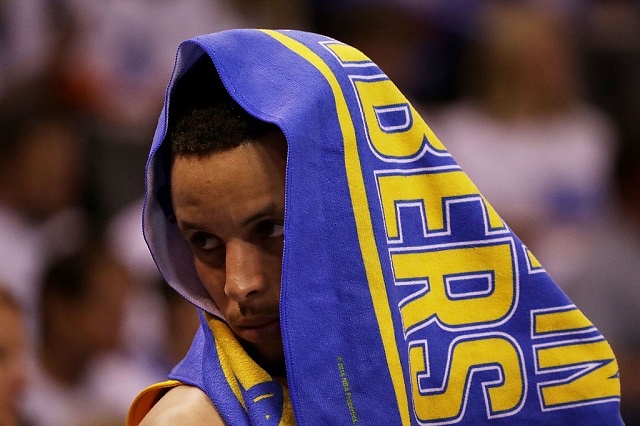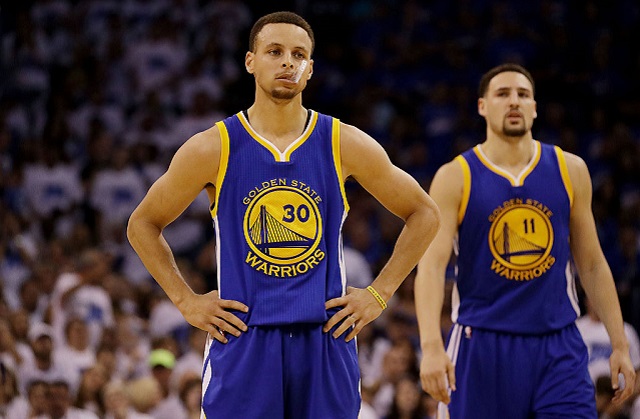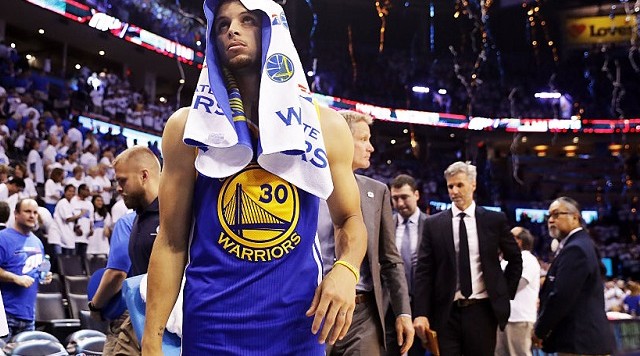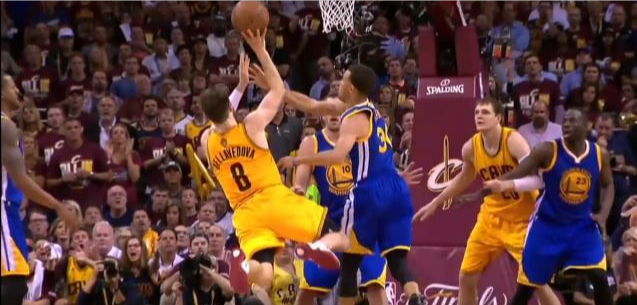The Golden State Warriors are staring into the abyss. Maybe that’s a little strong, but that’s how it feels the morning after one of the most dramatic thumpings any team has absorbed in NBA playoff history.
Don’t be fooled by the 28-point margin the Oklahoma City Thunder enjoyed when the buzzer sounded at the end of Game 3. It doesn’t come close to telling the story of how thoroughly they worked the Warriors in taking a 2-1 series lead in the Western Conference Finals.
If you’re reading this, you probably watched Sunday’s game, so I’ll spare you the numbers — except to say that seeing a “-39” next to Steph Curry’s name in the box score is a little startling.
Several aspects of the Thunder’s 133-105 win demand attention, so let’s cover them.
Who Are The Thunder?
Before the series started, I wrote that the NBA didn’t know who Oklahoma City really was, and more precisely, how much of its success against San Antonio was due to the Spurs decaying before our eyes. I think we have that answer now.
The Thunder are really freaking good, the best team the Warriors have faced in this two-year stretch of excellence. Does that mean that the Warriors can’t come back and win Game 4? Of course not. So far, each game in the series has been won by the team that really needed it, not the team that wanted it. In Game 4, that will be Golden State.
Oh, wait a minute: The Thunder really need Game 4, too.
Game 4 is the first game in this series that’s a must-win for both teams. That’s an unusual circumstance, much as Game 5 in the Portland series was a must-win close-out, which hardly ever happens in Game 5 of a 3-1 series. If the Warriors win, they’re back in the drivers’ seat with a three-game series and two games at home. If the Thunder win, they go up 3-1, with a home game in hand and three chances to finish the job.
I wrote a piece earlier this season about the Thunder, and how the team had been rocked by the tragic death of Ingrid Williams, the wife of assistant coach Monty Williams. That awful event led Monty Williams to leave the team within a regular season which also included the overlapping loss of assistant Maurice Cheeks, who had emergency hip surgery. I mentioned how Billy Donovan, plucked from the college ranks, really missed those guys while designing game plans for NBA opponents.
Cheeks is back, and he’s the Russell Westbrook coach. You can see him talking to Westbrook all the time and Westbrook is obviously listening. As for Donovan, he’s showing that when he gets into a series, he can make the game-to-game adjustments that enable him to keep up with his counterpart on the other bench. He’s already beaten Gregg Popovich and he has Steve Kerr in a must-win headlock, so he’s doing something right.

OKLAHOMA CITY, OK – MAY 22: Draymond Green #23 and head coach Steve Kerr of the Golden State Warriors argue a call with referee Tony Brothers #25 in the second quarter against the Oklahoma City Thunder in game three of the Western Conference Finals during the 2016 NBA Playoffs at Chesapeake Energy Arena on May 22, 2016 in Oklahoma City, Oklahoma. (Photo by J Pat Carter/Getty Images)
What’s Up With Those Refs, Anyway?
This is a touchy one. After all, the Warriors lost — for all intents and purposes — a 40-point game, so it may seem crazy (and worse, unobjective) to even bring up the referees.
I’m going to do it anyway.
First of all, I’m not saying the referees cost them the game. That’s an absurd notion. What they did do is dig a hole for the Warriors, from which the team did not emerge. That’s disconcerting in itself, for reasons I will explore shortly. But it still needs to be said that while the Warriors were not the better team in the first half of Game 3, they were right in it until a three-call sequence that changed everything:
1. Kevin Durant’s airball (OKC leading, 36-35, 9:42 to go, 2nd Q)
This play was originally called correctly by Zach Zarba, who was closest to the basket, but overruled by Scott Foster at midcourt. Foster said the ball hit the rim, which a replay indicated it did not. Foster didn’t say, “Hey, Zach, let’s look at that.” He simply overruled his partner. The Thunder got a Westbrook dunk on the inbounds pass.
2. Ball out of bounds (40-40, 8:19 2Q)
Serge Ibaka took a three from the right corner. It went out of bounds off Steven Adams. Referee Tony Brothers said it went off Draymond Green, who had inside position on Adams but didn’t get his hands up in time to get the missile fired by Ibaka. Foster looked for a second like he was going to overrule again, but he didn’t. The Thunder got a layup for Adams on the extra possession.
3. The already-infamous Green-Adams kick (OKC, 48-40, 5:57 2Q)
The two previous gifted possessions had re-energized the Thunder, and they had built their lead back to eight points. You know what happened, although we may not agree on all of the details.
Monday… https://t.co/9ObdMvnyO2 https://t.co/VRdGPSiqlM
— SB Nation (@SBNation) May 23, 2016
My position is pretty simple: When you watch that play in real time, you see that there’s no way Green could have kicked Adams on purpose. He knew he had gotten fouled (the first shooting foul on OKC in 18 minutes of action), and wanted to make sure he got the call. He did what James Harden, Russell Westbrook, and any number of other players do all the time, which is flail his arms and legs to get the officials’ attention.
If the NBA investigators use super slo-mo cameras to make that decision, he’s getting suspended. If they look at it in real time, not only won’t he be suspended, but the flagrant foul could be rescinded. It’s that obviously an accident when you see it in real time.
This became a much bigger deal because of two events that happened previously: Green’s also-accidental kneeing of Adams in the same spot in Game 2, and the Cavaliers’ Dahntay Jones throwing a very not-accidental punch to the same area belonging to the Raptors’ Bismack Biyombo in Game 3 of the East Finals the night before.
The NBA suspended Jones on Sunday, which might have been enough to seal Green’s fate, even though the game situations couldn’t have been less similar. Jones did his thing with a few seconds to go in an already-decided game and had nothing to do with basketball. Green’s kick occurred during the course of a basketball play in a hotly contested (at least at that moment) game.
In three plays, Thunder got six points they didn’t deserve. Six points didn’t make the difference, but the way the game changed during those three minutes of clock time, the way the crowd went crazy, and the way Green pretty much disappeared all affected the remainder of the game.

OKLAHOMA CITY, OK – MAY 22: Stephen Curry #30 of the Golden State Warriors covers his face in the fourth quarter against the Oklahoma City Thunder in game three of the Western Conference Finals during the 2016 NBA Playoffs at Chesapeake Energy Arena on May 22, 2016 in Oklahoma City, Oklahoma. (Photo by Ronald Martinez/Getty Images)
Where Was the Warriors’ Comeback?
This is the biggest concern for the Warriors and their fans.
It wasn’t the first time we saw them toss the white flag early in a second half, but it sure hasn’t happened in a playoff game. A little remembered fact about Game 3 of the NBA Finals last year was that the Warriors didn’t let go of the rope even when trailing by 17 heading into the fourth quarter. They came all the way back to make it a one-point game, until Matthew Dellavedova hit that circus shot while falling down to give the Cavaliers some space. Still, the Warriors had fought gamely and kept LeBron James on the floor for 46 minutes.
They didn’t lose again in the series.
That’s only one example of the Warriors not knowing when to quit, which is why it was strange to see them unable to get a stop in the third quarter Sunday night. Usually they clamp down on the defensive end to get back in ballgames, but that did not happen in Game 3.
I do want to propose one theory. It’s not an excuse, and nobody is “blaming the schedule,” but the simple fact is that the Warriors are now 1-3 in the playoffs when they have more than two days off, and only one of those losses was without Curry. The other two are the two losses in this series.
Steve Kerr mentioned in the shootaround before Game 3 that the third day of the layoff was a problem. There just isn’t enough you can do to use all that time, and even if you’re treating an injury, you can get out of rhythm. The Thunder had the same layoff, but they’re obviously a different cast of characters, and I have no idea how they respond to extra days off. I just know Kerr mentioned it as a problem, and then his team played pretty poorly — again — in a long-layoff situation. It happened last year in the Memphis series, which also involved a long interruption between Games 2 and 3.
One more point about Game 3s after long layoffs: Draymond Green played poorly in the first half of Game 3 against Portland, which was also a long-layoff game (a Saturday after a Tuesday). This is not an isolated event, and a team as resourceful as the Warriors needs to be better at handling such a situation.
Golden State would love the chance to play at least one more long-layoff game this year… which would mean a spot in the NBA Finals. That prospect has never stood on shakier ground.

OKLAHOMA CITY, OK – MAY 22: Stephen Curry #30 and Klay Thompson #11 of the Golden State Warriors react in the second quarter against the Oklahoma City Thunder in game three of the Western Conference Finals during the 2016 NBA Playoffs at Chesapeake Energy Arena on May 22, 2016 in Oklahoma City, Oklahoma. (Photo by Ronald Martinez/Getty Images)
What does a Warriors fan hang his or her hat on?
The Warriors have not lost two games in a row this season.
They burn to win, and that has been enough to carry them whenever they’ve stumbled: 9-0 during the regular season, 3-0 in the playoffs. I have to think that will play a role in Game 4. It better.
They know intellectually what they need to do — move the ball, move themselves — but that mantra has gone out the window twice in this series. They seem to need Kerr to say, “Okay, nobody shoots until there have been five passes!” He’s probably not going to do that.
However, as was the case last year, Kerr must find a way to re-orient his team in the face of a 2-1 series deficit on the road.




